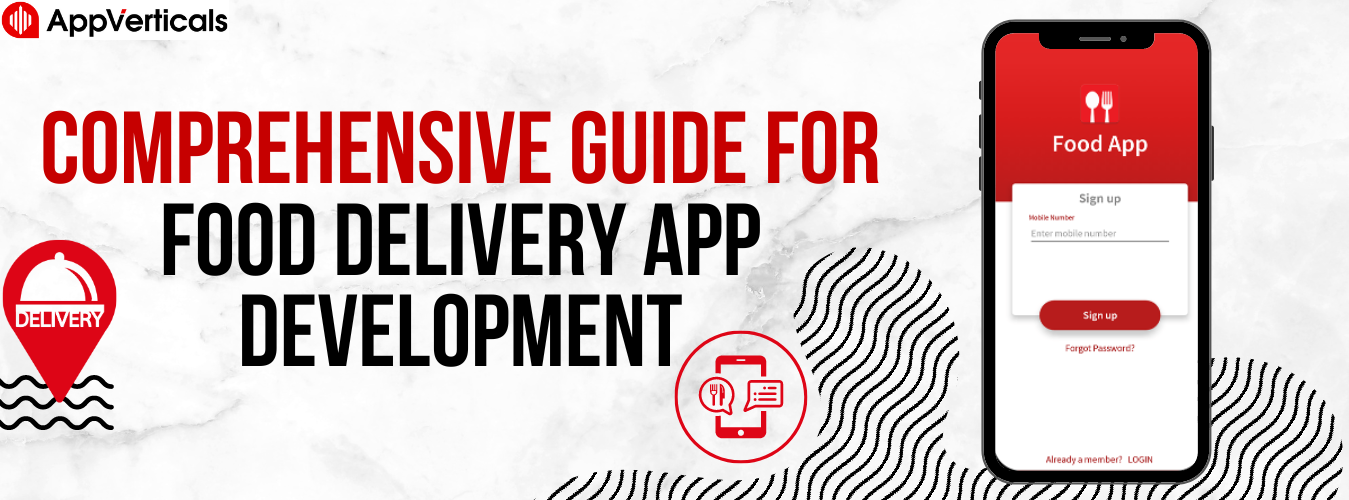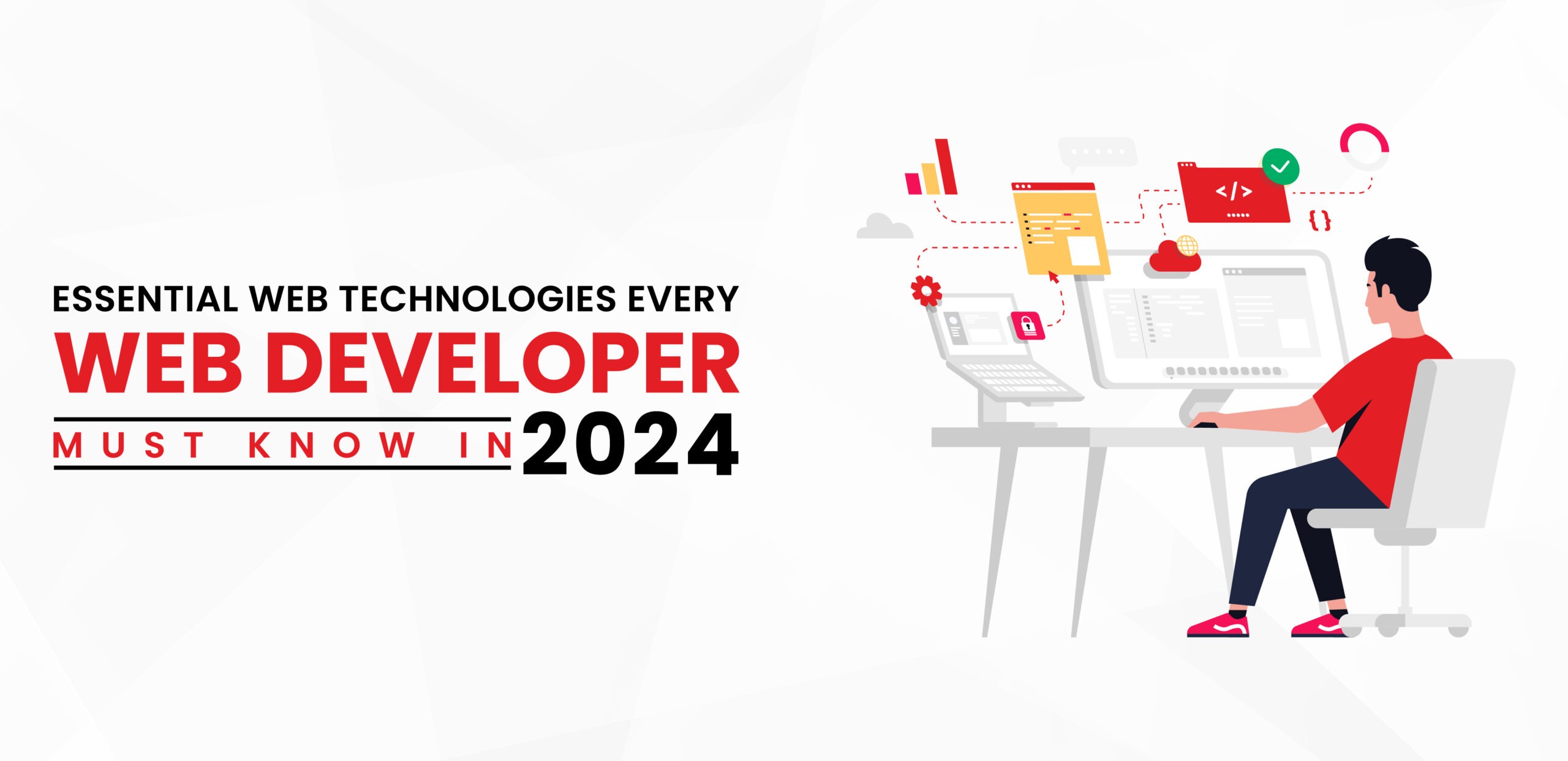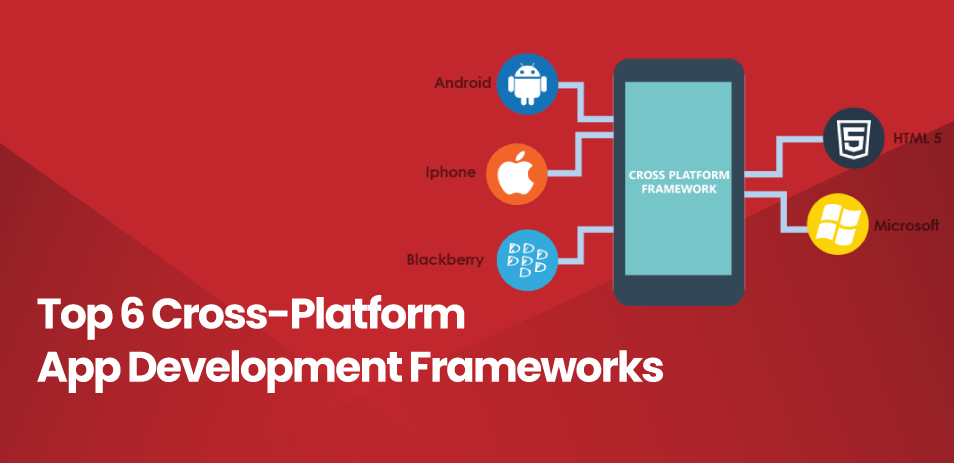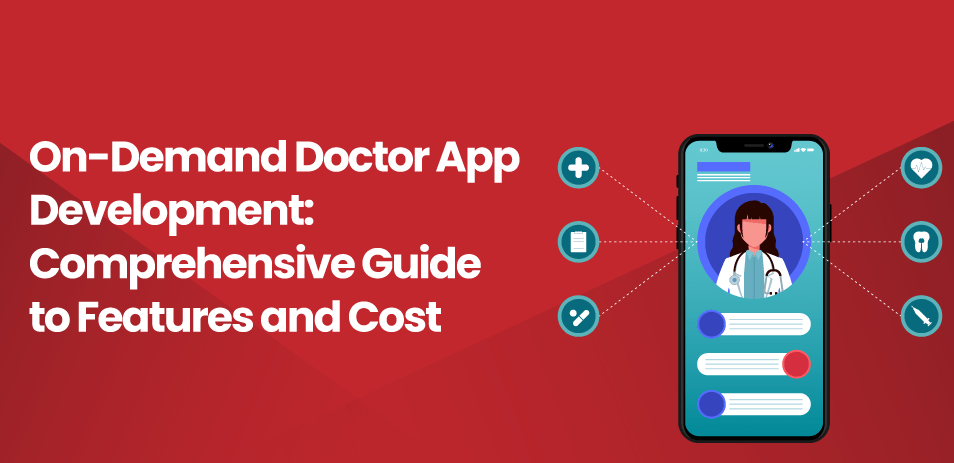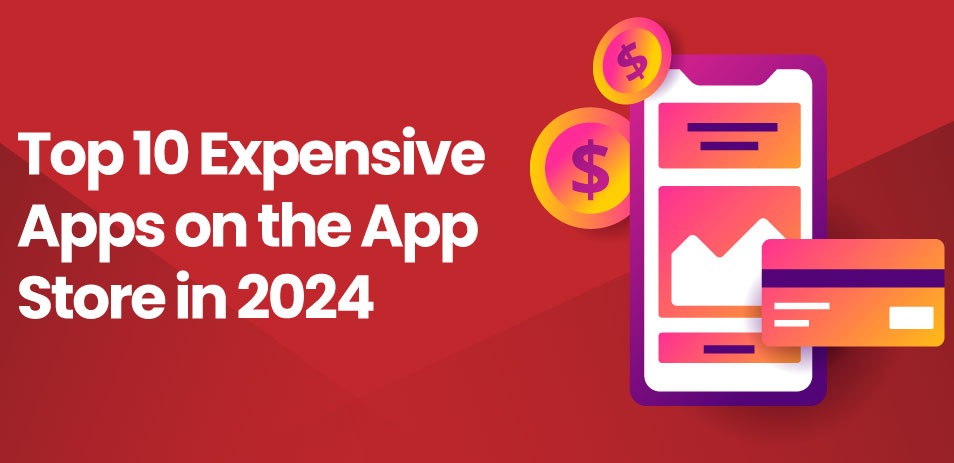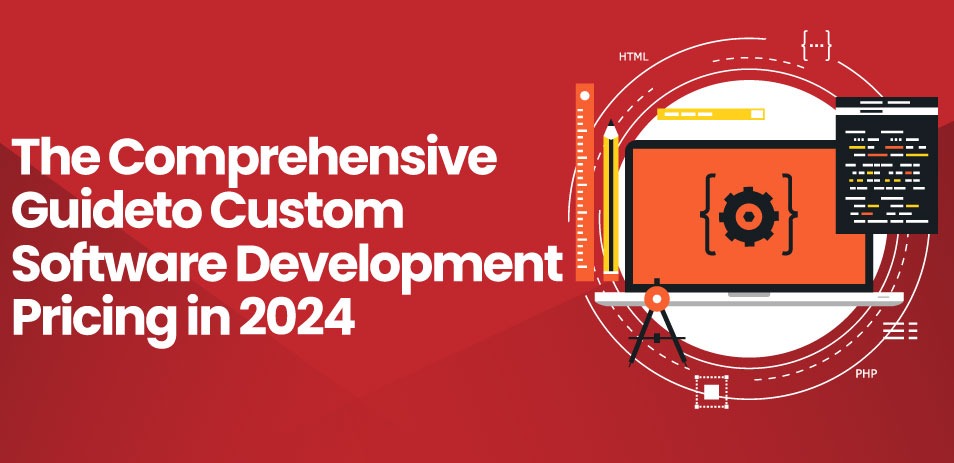The rise of mobile applications has changed numerous sectors, and the food delivery industry is no different. Mobile apps have completely changed how we order and get our favorite foods in today’s fast-paced, convenience-driven world. Mobile app development companies in Dallas have emerged as significant competitors in this competitive environment due to the rising demand for effective mobile food delivery apps and services. These businesses have developed innovative solutions for third-party delivery services that effortlessly connect hungry clients with a wide variety of gastronomic delights by leveraging their skills in food delivery application development. In this blog, we explore the unique solutions and business models used by mobile app development companies in Dallas to alter the food delivery app development market, changing how we satiate our desires.
Over the past five years, there has been a noticeable increase in the market for the food delivery business and startups. Food delivery market has evolved beyond takeout to anything and everything, driven by platform-to-consumer businesses like DoorDash and Uber Eats, adding billions of dollars in potential revenue collection.
A faster and less expensive food delivery platform has been made possible by the network effects of more delivery riders and route optimization technologies. Many other food delivery companies and businesses have seen a flywheel effect as a result, and they are now trying to undercut the competitors on extremely slim profit margins to gain market share.
Recently, a few aggregators (Eat, Grubhub, etc.) have adopted this platform-to-consumer strategy in which they are in charge of both the ordering and delivery processes.
Although Deliveroo, DoorDash, and Uber reported more revenue and gross bookings in 2021 than in 2020, this demand boom has subsided since that year. To compete with Getir and Gorillas, a number of applications introduced quick grocery delivery services.
Most food delivery apps’ valuations have dramatically decreased from 2020 to 2022. Most food delivery apps continued unprofitable throughout the pandemic, and the market sentiment has changed from growth to profitability.
Food Delivery Mobile App Development Stats
- By 2027, the global market for the online food delivery market is anticipated to grow to $1.65 trillion.
- The US will have the largest market for food delivery in 2022, with a $760 billion market.
- DoorDash, which holds a 65% market share in the United States, is the most widely used food delivery app.
- Uber Eats, Grubhub, and Postmates are the other leading food delivery apps in the US.
- The typical American orders food for delivery ten times a year.
- In the US, the average cost of a food delivery order is $30.
- Pizza, Chinese, and Mexican food are the most popular cuisines for delivery orders.
Also Recommended: Mobile App Development Cost
Most Popular Food Delivery Apps
Let’s look at the top five most used food delivery apps before learning how to create an on-demand food delivery app.
1- DoorDash
With a market share of 59%, DoorDash is the USA’s most widely used food delivery app. It provides a huge selection of restaurants, and compared to other applications, its delivery costs are typically lower.
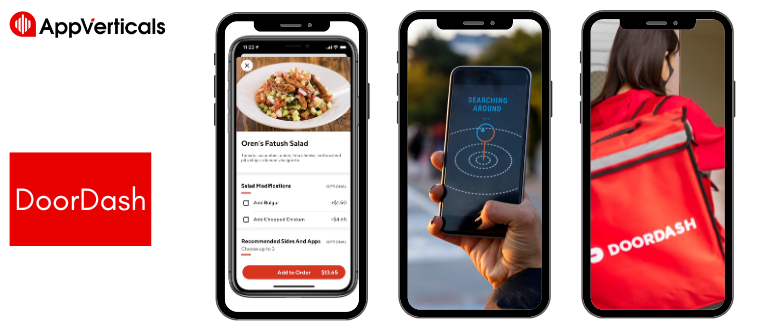
2- Ubereats
With a 24% market share, Uber Eats is the USA’s second most used food delivery app. Similar restaurants are available. However, the cost of the delivery fee is a little bit higher than with DoorDash.
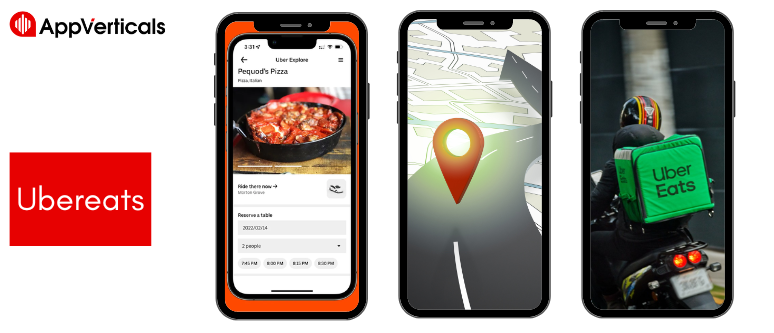
3- Grubhub
With a 20% market share, Grubhub is the USA’s third most used food delivery app. It offers many eateries, many of which are local favorites. Additionally, Grubhub provides a loyalty program that gives customers free food and savings.
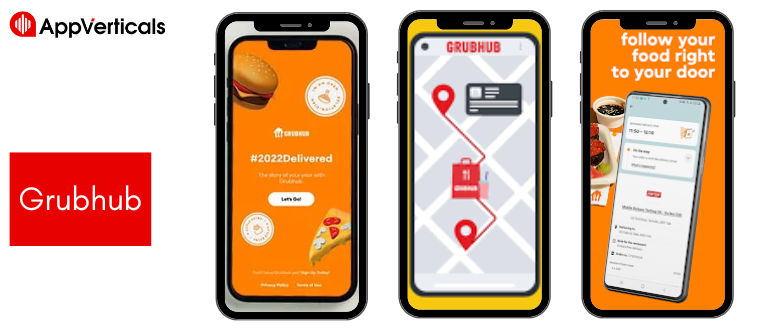
4- Postmates
A food delivery service called Postmates also sends out groceries, wine, pet supplies, and food. Its market share is lower than the other applications on this list, but it is still a decent choice if you require a speedy grocery delivery service.
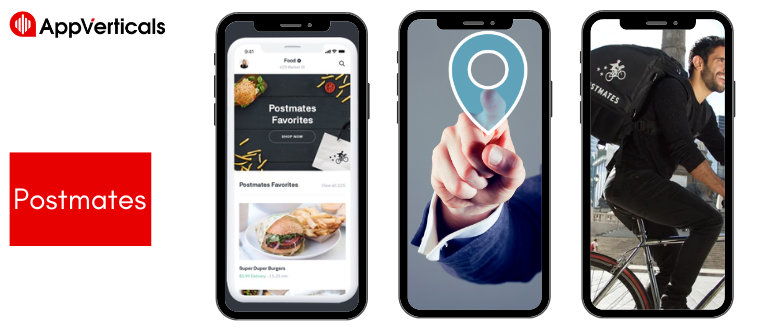
5- GoPuff
GoPuff is a rapid delivery app that delivers food, beverages, and other necessities quickly. This is a good alternative if you need something delivered at night or in a hurry.
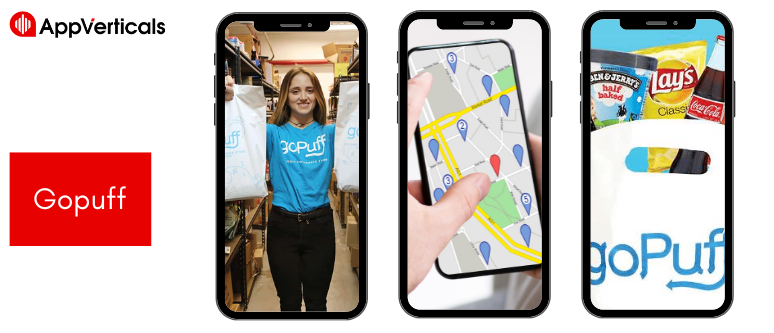
6- ChowNow
Local restaurants are the main emphasis of the food delivery service ChowNow. This is a fantastic choice if you want to support your neighborhood food businesses.
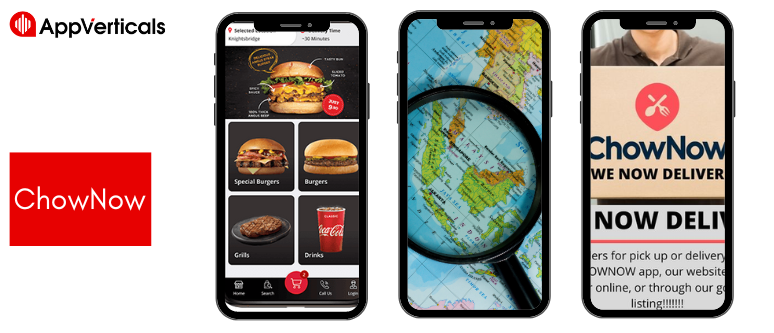
7- Delivery.com
Delivery.com provides a huge selection of restaurants and makes food delivery many choices. It is a good choice if you want a more conventional food delivery experience.
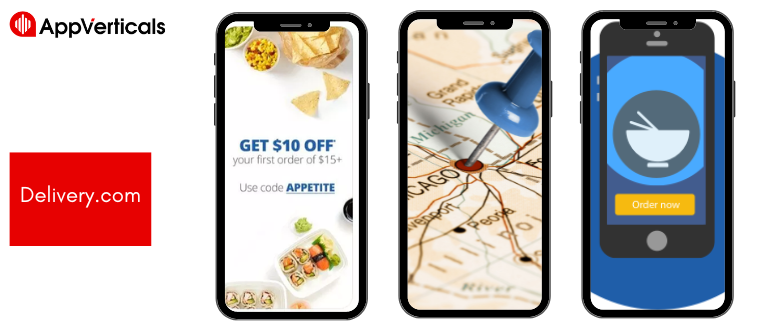
Food Delivery App Development Business Model
Aggregator Business Model
The aggregator business model is the most common business model utilized by food delivery apps like Uber Eats, Grubhub, and DoorDash. According to this approach, the food delivery app developers serve as a platform to link customers with different restaurants and eating places. This model’s main characteristics are:
- Order and Delivery Model: Customers can use the app to explore menus, place orders, and pay to order food online. The app then designates a delivery partner to pick up and deliver the order to the consumer after sending it to the appropriate restaurant for preparation.
- Revenue Generation: The app makes money by charging restaurants commissions or other fees for each order placed through the system. They might also charge delivery costs or offer subscription-based benefits like free delivery or discounts.
Integrated Model
Food delivery services like Domino’s and Pizza Hut, which have their delivery networks and run their own restaurant chains, adhere to the integrated concept. The main characteristics of this model are:
- Order and Delivery Model: The app automates the entire order process, from preparation to delivery, and customers may place orders directly through the app or website. The app employs its delivery drivers fleet or collaborates with outside logistics companies.
- Revenue Generation: Food sales produce income, with a portion of that income going to pay for delivery fees and app upkeep. Additionally, some apps could charge extra money for expedited shipping or premium services.
Inventory Business Model
Food delivery services like FreshMenu and Swiggy Access use the inventory business model and own or operate their central or “cloud kitchens.” The main characteristics of this model are:
- Own Food Production: The app runs its central kitchens or collaborates only with eateries for production. They are in charge of the food’s preparation and quality and keep their own inventory.
- Order & Delivery Model: Customers may use the app to place food orders, which controls every process step, from food preparation to delivery. They either have their own delivery fleet or work with outside logistics companies.
- Revenue Generation: Food sales produce income, with a portion of each order going to the food app development itself. Those who develop a food delivery app also may optimize costs and control the supply chain by effectively controlling ingredients and production.
Main Features of Food Delivery Services
User Side
From a client’s perspective, a food delivery app should provide a seamless and user-friendly experience. By incorporating these client-centric features, food delivery apps can provide a convenient and enjoyable experience, fostering customer loyalty and satisfaction.
Here are some essential features that users expect in a food delivery app:
1- Intuitive User Interface:
The app should have a visually appealing and easy-to-navigate interface, allowing users to browse nearby restaurants, menus, and food items quickly.
2- Search and Filters:
Users should be able to look for particular restaurants, foods, or cuisines. Users can find exactly what they’re looking for with the aid of filters based on dietary choices, pricing range, estimated delivery time, and ratings.
3- Menu Customization
By choosing choices like toppings, extra ingredients, and specific instructions, app users should be able to tailor their foods. Users can customize their foods based on their preferences thanks to this function.
4- Secure Payment Options
The app should support multiple payment options, including credit/debit cards, mobile wallets, and cash on delivery. Users should have faith in the security of their financial information.
Real-time Order Tracking: Customers value being able to follow their orders in real-time. Users are kept up to date on the status of their deliveries thanks to this function, which also offers transparency.
5- Ratings and Reviews
Users ought to have access to restaurant and delivery partner ratings and reviews. This function guarantees quality control while assisting consumers in making educated judgments.
6- Order History and Reordering
Users should be able to reorder their favorite dishes or keep track of previous orders thanks to the app’s storage of order history.
7- Customer Support
Customer service that responds promptly is crucial. Customers should have access to a hotline or chat option to handle any worries, questions, or problems they could have while placing a purchase.
8- Promotions and Discounts
Promoting discounts, loyalty programs, and promotional offers can increase user engagement and promote repeat business.
9- Integration with Social Media
It can help build buzz and draw new users if users can post their dining experiences or cuisine recommendations on social media channels directly from the app.
For Restaurant
A food delivery app should provide features that increase make a food delivery restaurant’s operational effectiveness and enable it to reach a larger consumer base. A food delivery app may give restaurants the resources and abilities they need to streamline operations, enhance customer service, and promote business growth by including these restaurant-specific features.
Here are some key features that restaurants expect in a food delivery app:
1- Online Menu Management
The app should have a user-friendly interface for restaurants to manage and update their menus, including adding new dishes, changing prices, and showing availability.
2- Order Management System
An effective order management system that enables restaurants to receive, confirm, and track orders in real time should be included in the app. It needs to enable simple client interactions and deliver push notifications for fresh orders.
3- Integration with POS System
The order process is streamlined through integration with the restaurant’s point-of-sale (POS) system, which also minimizes manual data entry. It guarantees precise order fulfillment and inventory control.
4- Preparation Time Control
Restaurants must be able to give delivery details and specify the approximate time each dish will take delivery personnel to prepare. This feature assures prompt delivery order food while managing consumer expectations.
5- Delivery Management
The app should have tools for assigning delivery partners, monitoring their locations, and planning the best delivery time and routes to manage the delivery process efficiently. This enables restaurants to guarantee effective and timely deliveries.
6- Customer Feedback and Ratings
Restaurants should have access to the reviews and ratings that customers leave on the app. Utilizing this data will help maintain customer contentment, fix problems, and enhance service quality.
7- Analytics and Reporting
Data and analytics on order quantities, consumer preferences, top products, and sales trends must be available through the app. This data aids in the optimization of restaurant operations and the making of knowledgeable business decisions.
8- Marketing and Promotions
Data and analytics on order quantities, consumer preferences, top products, and sales trends must be available through the app. This data aids in the optimization of restaurant operations and the making of knowledgeable business decisions.
9- Payment and Settlement
The app should feature a trustworthy payment system that guarantees prompt order settlements. Transparent financial reports and transaction information have to be available to restaurants.
10- Integration with Loyalty Programs
If one exists to develop a food delivery one, the app should smoothly work with the restaurant owner’s loyalty program. This enables establishments to use the food delivery app to reward and keep repeat customers.
How to Create a Food Delivery App?
Creating a food delivery app involves several important steps, from planning and designing the app to developing the backend infrastructure and launching it on various platforms. Creating a successful food delivery app requires ongoing maintenance, updates, and customer support. Continuously iterate and improve your own food delivery app based on user feedback and changing market dynamics to provide an exceptional user experience and stay ahead in the competitive food delivery industry.
Here is a detailed guide on how to create a food delivery app:
Market Research and Planning:
- Carry out market analysis to determine your target market, rivals, and market trends.
- Describe your own delivery app development company’s features and special selling factors that set it apart from all other food delivery services and applications.
- Write a thorough business plan that includes financial estimates, marketing plans, and revenue streams.
Define App Features and Functionality:
- List the essential functions that your food delivery software must have, such as user registration, menu browsing, ordering, payment integration, order tracking, and customer feedback.
- Identify extra features like promotions, rewards programs, live chat assistance, and social media platform integration.
- Sort features according to significance and viability.
User Experience (UX) and User Interface (UI) Design:
- Create an interface that is simple to use and corresponds with the preferences of your target audience.
- Produce wireframes and prototypes representing the app’s design, navigation, and user interface.
- Put your attention on designing a streamlined and aesthetically pleasing user experience across all platforms and devices.
Backend Development:
- Choose an appropriate tech stack for backend development based on scalability, security, and performance.
- Create a solid backend infrastructure to support menu maintenance, order processing, alerts, and integrations with payment gateways and user authentication.
- Set up a database system to keep track of user information, menus, orders, and other pertinent data.
Frontend Development:
- Create the app’s front end using the proper frameworks, such as HTML, CSS, and JavaScript.
- Ascertain that the front end is responsive and appropriate for various screen sizes and devices.
- Put the UI design you established previously into practice and enhance user interaction and navigation.
Integration of Third-Party Services:
- Implement payment gateway integration to enable safe and practical online transactions.
- Use geolocation services to track deliveries accurately and offer location information.
- Establish a connection with SMS and other push notifications and notification systems to update users on orders in real time.
- Integrate with well-known social networking sites to provide easy user authentication and sharing.
Testing and Quality Assurance:
- Run thorough tests to find and address any defects, usability problems, or performance bottlenecks.
- Conduct functional testing, usability, compatibility, security, and other tests.
- Check that the app works properly in various user circumstances, such as heavy traffic and several orders being placed at once.
Deployment and Launch:
- Use the appropriate development rules for each platform to deploy the program on, for example, iOS and Android.
- Add engaging descriptions, screenshots, and ratings to the app store listings.
- Consider launching an initial version with just a few clicks and a minimal feature set and introducing upgrades progressively based on user input.
User Feedback and Iteration:
- Encourage people to rate and comment on products for ongoing improvement.
- Examine user behavior and app usage data to find areas that could use improvement.
- Update the software frequently with bug patches, performance enhancements, and new features to keep up with user demand and remain competitive.
Marketing and Promotion:
- Create a thorough marketing plan to draw people to your food delivery service.
- Use digital marketing strategies like targeted online campaigns, influencer relationships, social media advertising, and search engine optimization (SEO).
- Work with nearby eateries, provide promotional offers, and use word-of-mouth advertising to boost restaurant app visibility.
Crafting Your Ideal Mobile App/Experience Starts Here!
Ready to elevate your business? Your custom app is just a click away.
Yes Let’s goFood Delivery App Monetization
Food delivery apps employ various monetization strategies to generate revenue. It’s important to note that specific monetization strategies may vary depending on the region, market dynamics, and the business model of the food delivery Android app developers.
Here are some common approaches:
Commission Fees
Food delivery apps receive a commission from restaurants for each order placed on their platform, which is one of their primary sources of income. This charge often represents a portion of the entire order amount—the commission charges for platform upkeep, marketing, and user acquisition expenses.
Delivery Fees
For the convenience of having foods delivered to their doorstep, many food delivery apps charge users a delivery fee. This price may change depending on the order’s value; the distance traveled, and the time of day. For a monthly or annual cost, some applications offer subscription-based services, such as free delivery.
Surge Pricing
Food delivery apps may use surge or dynamic pricing or peak pricing during peak hours or times of intense demand. To balance supply and demand, prices must temporarily be raised. Surge pricing guarantees a seamless delivery experience and encourages delivery partners to handle the increased demand.
Advertising
Apps that deliver food frequently make money by partnering with advertisers. Within the app, they can show tailored advertisements for particular eateries or food-related products. Banners, sponsored listings, and prominent placements are all examples of ads. For popular apps with a huge user base, advertising might offer an extra source of income.
Restaurant Promotions
Food delivery services and restaurants may work together to offer promotions and discounts to attract more consumers. Due to these collaborations, the food ordering app may receive more orders, and the other restaurant owners may gain more exposure and patrons. The food delivery app cost charges the restaurant for featuring its specials or providing discounted foods.
Data Analytics and Insights
Food delivery applications gather much information about consumer preferences, ordering patterns, and fad diets. They may profit from this data by offering partner restaurants or food manufacturers insights and analytics. Restaurants can target particular client categories, optimize their menus, and enhance all aspects of their operations using the data.
White-Label Solutions: For restaurants, several food delivery services create white-label solutions that let them have their own branded online food ordering apps, and food delivery apps work as platforms. Restaurants employ the food delivery app development’s technology backbone in exchange for a licensing fee or a share of sales.
Subscription Models: Some food delivery services provide subscription programs that grant users advantages like free delivery, special discounts, or priority service. The subscription price encourages client loyalty and retention while introducing a regular revenue stream.
Why should you invest in online food delivery platforms and mobile app development?
Food delivery mobile app development is one of those company concepts that, if created and introduced correctly, cannot fail. The market for on-demand food delivery apps has expanded more than ever. Young people and senior citizens use food delivery applications to order their food, which has a large target audience. The development of food delivery mobile apps is anticipated to increase because of the widespread availability of smartphones and the lower cost of internet access due to the large number of individuals who choose to develop food delivery app services for breakfast, lunch, supper, and snacks to fit into their hectic schedules. As a result, there is a high demand for food delivery apps. Food delivery apps generate billions of dollars annually by meeting consumer demand.
Crafting Your Ideal Mobile App/Experience Starts Here!
Ready to elevate your business? Your custom app is just a click away.
Yes Let’s goConclusion
AppVerticals is mobile app development services provider in the USA. We now have everything needed to build a top-notch smartphone app for the online food delivery segment. We are committed to creating top-notch applications for popular online and mobile platforms like iOS and Android. The full food delivery application is combined with a powerful dashboard to assess and manage the entire mobile food ordering business to obtain an ultimate app solution with boards for customers and restaurants. Our complete system with state-of-the-art technology guarantees faultless functioning at all levels.
FAQ’s
How do I make a mobile food delivery app?
A mobile food delivery app requires several essential processes to be created. To start, undertake market research to determine your target market and rivals. Create a list of the app’s functions, such as registration, ordering, menu browsing, payment integration, order tracking, and reviews. Create a user interface and experience that is simple and intuitive. To handle login, menu management, order processing, and alerts create a strong backend architecture. Sync up with messaging platforms, geolocation services, and payment gateways. Test thoroughly to guarantee functionality and get rid of issues. Install the app on the appropriate platforms and continually collect user input to make improvements. To draw users, successfully market the software. For long-term success, regular updates and maintenance are necessary.
How much does developing an on-demand food delivery app like this cost?
The price of creating an app for on-demand food delivery might change depending on several variables. The complexity of the features, the supported platforms (iOS, Android, or both), the complexity of the design, the number of development hours, and the location of the development team are important variables that affect the cost. A food delivery app’s development typically costs between $30,000 and $150,000. Working with a professional app development firm that can offer a thorough project estimate based on your unique requirements is essential. Investing in high-quality software with powerful functionality and a great user experience is essential for long-term success in the cutthroat food delivery business.
How do food delivery apps make money?
- Customers are charged delivery fees for each order.
- Restaurant owners and partner commissions for each order placed through the app.
- Restaurants and restaurants pay money for advertising and promotion costs in exchange for more exposure and visibility.
- Subscription costs for exclusive content or membership schemes.
- Data monetization through the exploitation of user data for market research or targeted advertising.
What is a food delivery app?
A food delivery app is a mobile app for ordering food from different restaurants and having it delivered to a preferred location. Customers can browse menus, place orders, pay for them, and check the progress of their on-demand food delivery app, on this practical from platform to consumer delivery, which improves their whole eating experience.
Is Grubhub or DoorDash cheaper?
Prices for Grubhub and DoorDash might change depending on location, restaurant agreements, and special offers. It is advised to compare pricing for particular restaurants and orders across the two platforms to see which is most affordable right now. Fees, delivery costs, and service charges can all affect the final price.

